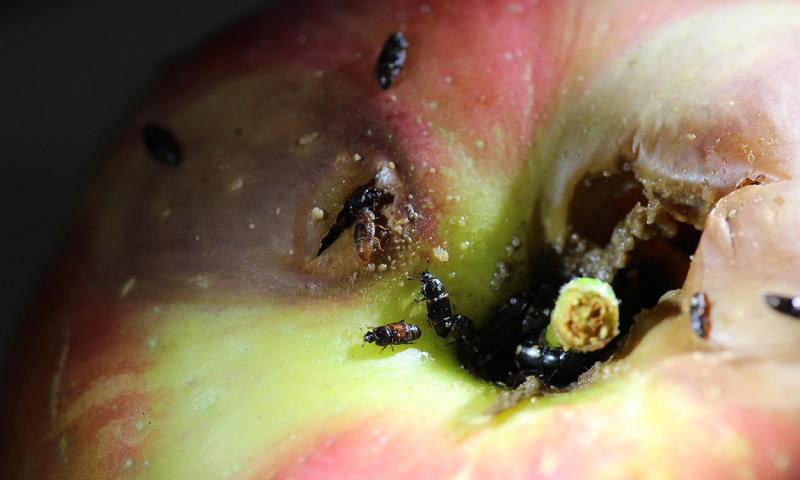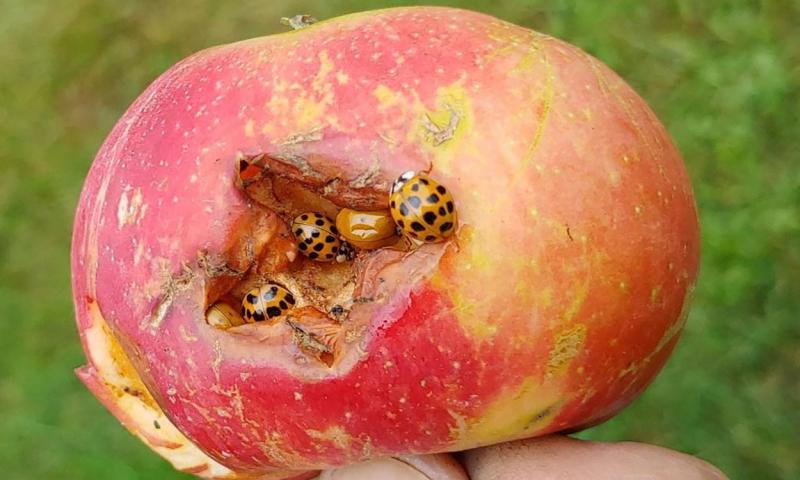
Originally Submitted: September 14, 2021
It’s frustrating to watch nearly ripe produce get destroyed by insects before it can be picked. Ripe fruit that has been injured and ground-fall fruits can attract undesirable insects into your garden. Some of these insects will feed on the produce, which can completely ruin it by increasing the rate of decay and make it unappealing. The two types of produce that these pests are most common on are tomatoes and apples.
For insects to be an issue, the skin of the fruit is typically damaged by something other than the insect pests, but it allows for them to begin feeding on the wounds. Commonly, small black beetles can be observed congregating in and around the wounds (Figure 1).

These beetles are commonly referred to as sap beetles, or picnic beetles, and they can become a pest from now until the first hard frost in gardens and orchards.
Picnic beetle adults are attracted to ripe or decaying plant matter, which they will feed on and lay eggs within. These beetles are normally an indicator of previous damage to the fruit but will also assist with the breakdown of the plant material.
In some cases, they can be a pest if they increase the size of the damaged area on fruits and vegetables, such as apples (Figure 2), strawberries, raspberries, sweet corn and tomatoes, or if they begin feeding on undamaged fruit. Picnic beetle feeding is usually associated with deep cavities in the fruit. Their feeding can also introduce fungal spores that will lead to additional breakdown of the fruit.

Sap beetles are about ¼ of an inch long, brown in color and do not have any spots. Picnic beetles are slightly larger than the sap beetles and are black in color. Picnic beetles also have four yellow-to-orange colored spots on their abdomens.
Another insect that can invade and reduce the quality of produce are the multicolored Asian lady beetles. Like the picnic beetles, the multicolored Asian lady beetles will aggregate near and in injured areas of apples and other produce (Figure 3). At this point, they will begin feeding to a degree, but will also leave an irreversible scent/flavor in the fruit. This often requires the fruit to be destroyed, as the flavor will persist even after processing the fruit or vegetables.
Protecting Your Garden Produce
The first thing to do to reduce picnic beetle, sap beetle or multicolored Asian lady beetle problems is to maintain a clean garden or orchard. Regularly remove any overripe, damaged, or diseased fruit and vegetables. Simply throwing them into a compost pile won’t be enough, as these beetles are mobile. The best strategy is to bury the infested fruits or destroy them using other means. This will remove the food sources and reduce the attractiveness of the garden or orchard.
If picnic or sap beetles are already present, bait traps can be used to attract and remove the beetles from the area. These bait traps can be made using a bucket baited with ripening fruit, bread dough, stale beer or vinegar. Similar traps may be effective for attracting multicolored Asian lady beetles. When using liquid bait, add a drop or two of liquid dish soap to break the surface tension of the liquid so the beetles will sink. These traps should be placed outside of the area that you are trying to remove the beetles from, and the contents need to be discarded every two-to-three days to prevent infestations from becoming worse. Once the contents are discarded, the traps should be rebaited and replaced until all produce can be harvested.
Insecticide applications to the plants are not recommended, as that would impact your ability to harvest the fruit. Many insecticides have a pre-harvest interval (PHI) for each crop in the label directions. The PHI lets you know how long after an application you have to wait to harvest and consume the crop.


